![]()
![]()
![]()
Use LEFT and RIGHT arrow keys to navigate between flashcards;
Use UP and DOWN arrow keys to flip the card;
H to show hint;
A reads text to speech;
48 Cards in this Set
- Front
- Back
- 3rd side (hint)
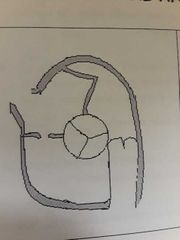
Which type of ASD is this? |
Ostium Secundum |
|
|
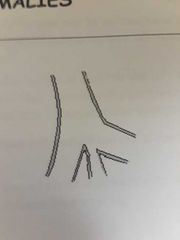
Usually closes within 15 hours of birth and seals within 2-3 weeks |
PDA |
|
|

What type of defect? |
Trabecular septal defect |
|
|
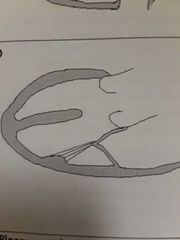
Most common cyanotic lesion in the adult population Children may experience squatting episodes Symptoms depend on size of VSD, the degree of pulmonic stenosis and the degree of aorta malalingment. |
Tetralogy of fallot |
|
|

Right ventricle become atrialized |
Ebstiens anomaly |
|
|
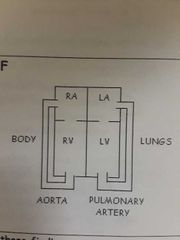
Two independent parallel circuits. Life depends on some intermixing of the two circuits. Arterial switch |
Dextro-TGA |
|
|
|
located in the inferior portion of the IAS. When the septum primum fails to fuse w/ the endocardial cushions |
Ostium primum |
|
|
|
VSD high on the septal wall near the valves |
Membranous septum Perimembranous septum And outlet septum |
|
|
|
Disruption of division of the common trunk into the pulmonary artery and the aorta |
Transposition of the great arteries |
|
|
|
When there is a communication between right and left heart blood travels |
From high pressure to low pressure |
|
|
|
Corrected TGA is when the anatomic RV becomes the___ and the anatomic LV becomes the___ |
Arterial ventricle Venous ventricle |
|
|
|
Results from failure of IAS to close and allows blood to shunt between LA and RA |
ASD |
|
|
|
Ostium secundum is the ___ common ASD. Located in the mid portion of the IAS |
Most |
|
|
|
small to medium VSD may close with growth of the child. Large VSD may require |
Surgery |
|
|
|
In a normal heart the pulmonary blood flow is equal to systemic bloodflow. The Qp:Qs ratio is___ |
1:1 |
|
|
|
The severity of cyanosis in the patient with D-TGA depends on the |
Intermixing of blood |
|
|
|
Sinus venosus ASD is located in the superior portion of the IAS near the junction of the |
SVC and RA |
|
|
|
What anomalies are associated with sinus venosus ASD? |
Partial anomalous pulmonary venous return |
|
|
|
Coronary sinus ASD is rare, located in the inferior septal area near the |
Coronary sinus |
|
|
|
VSD are usually |
7mm to 3cm in diameter |
|
|
|
Hemodynamic effect of an ASD depends on |
Size and direction, compliance if ventricles, and response of the pulmonary vascular bed |
|
|
|
Direction of blood through a shunt depends on |
Pulmonary vascular resistance and systemic vascular resistance |
|
|
|
In utero shunt usually travels |
Right to left Because the pulmonary vascular resistance is higher than the systemic vascular resistance |
|
|
|
Type of VSD that has a shunt between ventricle and atria, common is Downs syndrome patients |
Endocardial cushion defect |
|
|
|
Systemic flow travels from RA, RV, Aorta, body, RA Pulmonary venous flow travels from LA,LV,pulmonary artery,lungs,LA |
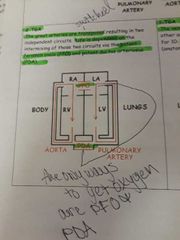
Dextro-TGA (d-tga or simple tga) Great arteries are switched |
|
|
|
Pulmonary venous flow travels to LA, anatomic RV, aorta, body Systemic flow travels to RA, anatomic LV, pulmonary artery,lungs, back to the LA again |
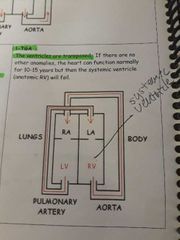
Levo TGA (l-TGA or corrected TGA) The ventricles are switched |
|
|
|
With ebstiens anomaly associated findings are |
PFO, ASD, and right heart failure |
|
|
|
Pulmonic stenosis in the RVOT creating RVOT obstruction |
Infundibular (subvalvular) |
|
|
|
Inlet septal VSD is located between |
AV valves |
|
|
|
With ASD and VSD Qp= and Qs= |
Qp=SVRVOT Qs=SV of the LVOT |
|
|
|
With a PDA Qp and Qs equal |
Qp= SVLVOT Qs=SVRVOT |
|
|
|
Trabecular or muscular VSD is located between the |
Ventricles and may present in multiples |
|
|
|
Supravalvular Pulmonic stenosis is in the |
Main pulmonary artery just above the pulmonic valve |
|
|
|
Abnormality where AO and PA rise from common trunk, blood from ventricles mix and exit through a single valve |
Truncus arteriosus |
|
|
|
Which view has best doppler angle for trabecular VSD |
Subcostal |
|
|
|
If the ductus arteriosus fails to close after birth, results in communication between ___ and ___ |
Aorta and pulmonary artery |
|
|
|
A hole in the center of the heart and a common valve |
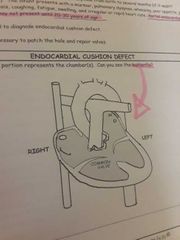
Endocardial cushion defect aka Atrioventricular canal defect aka Atrioventricular septal defect |
Butterfly appearance |
|
|
The severity of this depends on size of the VSD, degree of pulmonic stenosis and position of the aorta |
Tetralogy of fallot |
|
|
|
Cleft mitral valve involves a division I'm the anterior or or posterior leaflet |
Anterior (most common) Posterior (rare) |
|
|
|
Membranous or perimembranous VSD is between the AOV and the annulus of the |
Tricuspid valve |
|
|
|
Most common cause of pulmonic stenosis |
Congenital |
|
|
|
Infant with hypoplastic left heart syndrome may appear normal at birth. Soon after birth a sudden worsening of symptoms is caused by |
The ductus arteriosus and foramen ovale close |
|
|
|
If the peak pg is 50 mmhg what is the degree of pulmonic stenosis? |
Moderate |
|
|
|
Pulmonic stenosis PG method |
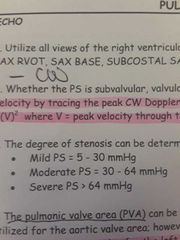
|
|
|
|
After birth, pulmonary vascular resistance is lower than systemic and shunt reverses ( pulmonary blood flow is increased so Qp:Qs is around 2:1) With Eisenmengers syndrome |
The shunt reverses direction again (0.7:1 ratio) |
|
|
|
Ostium primum (ASD1) |
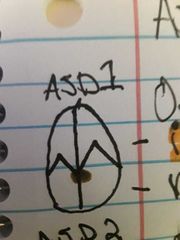
Inferior (closer to valves) May have deformed mitral valve Happens when septum primum fails to fuse with endocardial cushions |
|
|
|
Ostium secundum (ASD2) |
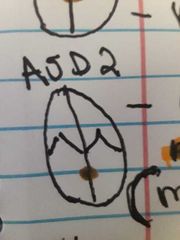
Most common Mid portion -in the secundum (not to be confused w/ pfo- between the primum and secundum) |
|
|
|
Sinus Venous ASD |
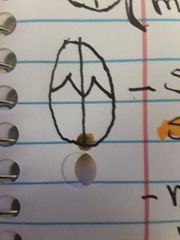
Superior - near the SVC and pulmonary veins May have partial anomalous pulmonary venous return |
|

